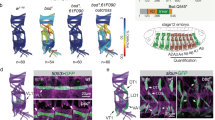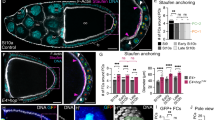Abstract
IN Drosophila the correct formation of the most anterior and posterior regions of the larva, acron and telson is dependent on the maternally expressed terminal class of genes1. In their absence, the anterior head skeleton is truncated and all the structures posterior to the abdominal segment seven are not formed1–6. The protein predicted to be encoded by one of these genes, torso (tor), seems to be a transmembrane protein with an extracytoplasmic domain acting as a receptor and a cytoplasmic domain containing tyrosine kinase activity7. Here we report that another member of the terminal-genes class, l(1)polehole (l(1)ph)2,3,8, which is also zygotically expressed, is the Drosophila homologue of the v-raf oncogene and encodes a potential serine-and-threonine kinase. We also show that functional l(1)ph gene product is required for the expression of a gain-of-function tor mutant phenotype, indicating that l(1)ph acts downstream of tor. Together, these results support the idea that the induction of terminal development occurs through a signal transduction system, involving the local activation of the tor-encoded tyrosine kinase at the anterior and posterior egg poles, resulting in the phosphorylation of the l(1)ph gene product. In turn, downstream target proteins may be phosphorylated, ultimately leading to the regionalized expression of zygotic target genes. Such a process is in agreement with the finding that both tor and l(1)ph messenger RNAs are evenly distributed.
This is a preview of subscription content, access via your institution
Access options
Subscribe to this journal
Receive 51 print issues and online access
$199.00 per year
only $3.90 per issue
Buy this article
- Purchase on Springer Link
- Instant access to full article PDF
Prices may be subject to local taxes which are calculated during checkout
Similar content being viewed by others
References
Nüsslein-Volhard, C., Frohnhofer, H., G. & Lehmann, R. Science 238, 1675–1681 (1987).
Perrimon, N., Engstrom, L. & Mahowald, A. P. Devl Biol. 110, 480–491 (1985).
Ambrosio, L., Mahowald, A. P. & Perrimon, N. Development 106, 145–158 (1989).
Degelmann, A., Hardy, P. A., Perrimon, N. & Mahowald, A. P. Devl Biol. 115, 479–489 (1986).
Perrimon, N., Mohler, D., Engstrom, L. & Mahowald, A. P. Genetics 113, 695–712 (1986).
Schüpbach, T. & Wieschaus, E. Wilhem Roux Arch. dev. Biol. 195, 302–317 (1986).
Sprenger, F., Stevens, L. M. & Nusslein-Volhard, C. Nature 338, 478–483 (1989).
Perrimon, N., Engstrom, L. & Mahowald, A. P. Genetics 108, 559–572 (1984).
Rapp, U. R. et al. Proc. natn. Acad. Sci. U.S.A. 80, 4218–4222 (1983).
Jansen, H. et al. Nature 307, 281–284 (1984).
Moelling, K., Heimann, B., Beimling, P., Rapp, U.R. & Saunders, T. Nature 312, 558–561 (1984).
Mark, G. E., Macintyre, R.J., Digan, M. E., Ambrosio, L. & Perrimon, N. Molec. cell. Biol. 7, 2134–2140 (1987).
Nishida, Y. et al. EMBO J. 7, 775–781 (1988).
Bonner, T. I. et al. Nucleic Acids Res. 14, 1009–1015 (1986).
Rapp, U. R., Cleveland, J. L., Storm, S. M., Beck, T. W. & Huleihel, M. in Oncogenes and Cancer (ed. Aaronson, S. A.) 55–74 (Japan Sci. Soc., Tokyo, 1987).
Morrison, D. K., Kaplan, D. R., Rapp, U. R. & Roberts, T. M. Proc. natn. Acad. Sci. U.S.A. 85, 8855–8859 (1988).
Klinger, M., Erdelyi, M., Szabad, J. & Nüsslein-Volhard, C. Nature 335, 275–277 (1988).
Strecker, T. R., Halsell, S. R., Fisher, W. W. & Lipshitz, H. D. Science 243, 1062–1066 (1988).
Strecker, T. R., Merriam, J. R. & Lengyel, J. A. Development 102, 721–734 (1988).
Weigel, D., Jürgens, G., Kuttner, F., Seifert, E. & Jackle, H. Cell 57, 645–658 (1989).
Frei, E. et al. EMBO J. 7, 197–204 (1988).
Lindsley, D. L. & Grell, E. H. in Genetic variations of Drosophila melanogaster (Carnegie Institution of Washington, Publication No. 627, 1968).
Mariani, C., Pirrotta, V. & Manet, E. EMBO J. 4, 2045–2052 (1985).
Maniatis, T., Fritsch, E. F. & Sambrook, J. in Molecular Cloning: a Laboratory Manual (Cold Spring Harbor Press, New York, 1982).
Brown, N. H. & Kafatos, F. C. J. molec. Biol. 203, 425–437 (1988).
Shi-Chung N. G., Perkins, L. A., Conboy, G., Perrimon, N. & Fishman, M. C., Development 105, 629–638 (1989).
Hafen, E., Kuroiwa, A. & Gehring, W. J. Cell 37, 833–841 (1984).
Perrimon, N. Genetics 108, 927–939 (1984).
Author information
Authors and Affiliations
Rights and permissions
About this article
Cite this article
Ambrosio, L., Mahowald, A. & Perrimon, N. Requirement of the Drosophila raf homologue for torso function. Nature 342, 288–291 (1989). https://doi.org/10.1038/342288a0
Received:
Accepted:
Issue Date:
DOI: https://doi.org/10.1038/342288a0
This article is cited by
-
A non-canonical Raf function is required for dorsal–ventral patterning during Drosophila embryogenesis
Scientific Reports (2022)
-
Regulatory mechanisms of EGFR signalling during Drosophila eye development
Cellular and Molecular Life Sciences (2016)
-
Regulation of RAF protein kinases in ERK signalling
Nature Reviews Molecular Cell Biology (2015)
-
The pea aphid uses a version of the terminal system during oviparous, but not viviparous, development
EvoDevo (2013)
-
Somatic control over the germline stem cell lineage during Drosophila spermatogenesis
Nature (2000)
Comments
By submitting a comment you agree to abide by our Terms and Community Guidelines. If you find something abusive or that does not comply with our terms or guidelines please flag it as inappropriate.



